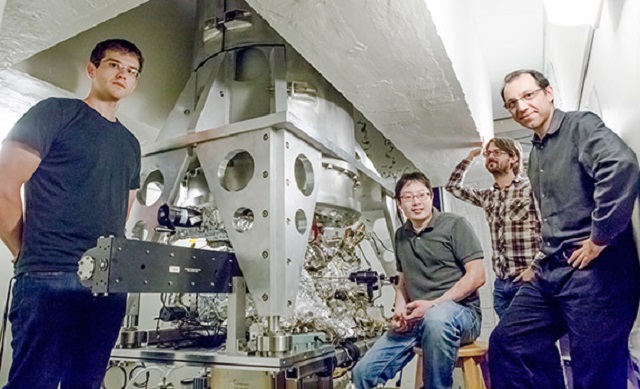 Photo by Denise Applewhite, Office of Communications
Photo by Denise Applewhite, Office of Communications
Researchers from Princeton University have discovered an unusual particle that behaves like both matter and antimatter at the same time. This math and engineering accomplishment could help in the development of powerful computers built according to quantum mechanics principles.
The research team used the floating two-story-tall microscope found in Princeton's Jadwin Hall ultralow-vibration lab to view the image of a particle referred to as "Majorana fermion", which has been studied from as early as the 1930s. The Majorana fermion was found to be on top of an atomically thin wire.
The researchers discovered how the Majorana fermion was stable despite being made up of both matter and antimatter, which in reality tend to destroy each other. The particle hardly interacted with the surrounding environment. This feature drew the attention of the researchers and prompted them to find ways to use it within materials, thereby providing a stable way to encode quantum data, which could then lead to a new phase of quantum computing.
According to the team, the Majorana fermion bound within a material is unique to physicists in comparison to the Higgs boson, which was discovered in a vacuum in giant accelerators.
Particles in materials depend upon or materialize from the properties of the atoms combined with the surrounding forces. When these interactions were controlled the Majorana fermions did not contain any impurities and was clean. This would not be possible in a Higgs boson type of experiment.
This is the most direct way of looking for the Majorana fermion since it is expected to emerge at the edge of certain materials. If you want to find this particle within a material you have to use such a microscope, which allows you to see where it actually is.
Ali Yazdani, a professor of physics who led the research team
In 2013, the researchers developed a new approach to discover how Majoranas could occur in materials that contained both superconductivity and magnetism.
They used a very pure lead crystal whose atoms can be found in irregular rows, thereby causing atomically thin ridges on the surface of the crystal. Then pure iron was placed on one of the ridges so as to build a wire measuring around three atoms thick. This structure was observed under the scanning-tunneling microscope after it was cooled down to -272°C. They then established that the superconductivity in the iron wire corresponded to the conditions needed for Majorana fermion to be developed in their material.
The microscope identified an electrically neutral signal found at the ends of the wires. The researchers were able to view the changes in the signal along the length of the wire, thus making it feasible to map the quantum probability of discovering the Majorana fermion along the wire, and finally indicating that it emerges at the ends of the wire, thereby proving that the signal exists only at the edge, which is its blueprint.
The researchers explained that their approach to discovering the Majorana particle is a lot simpler using only basic materials like lead and iron and it can be replicated easily. Iron provides the strong magnetic material required for this experiment, in which electrons are magnetically polarized, thus giving rise to the chances of Majoranas appearing. The magnetic field does not interfere with the superconductivity of lead.
Going forward, the researchers plan to swap iron and lead with other materials.
References